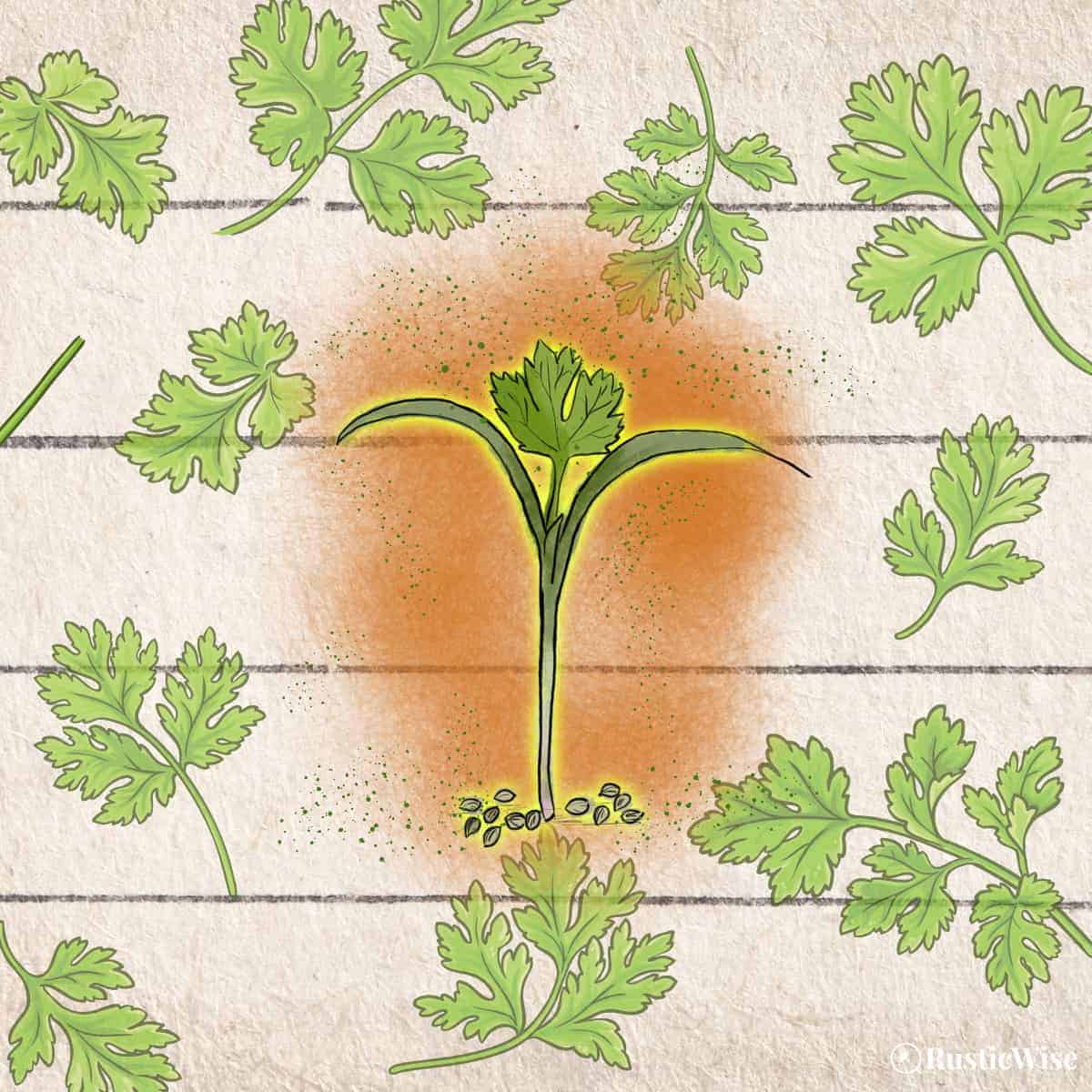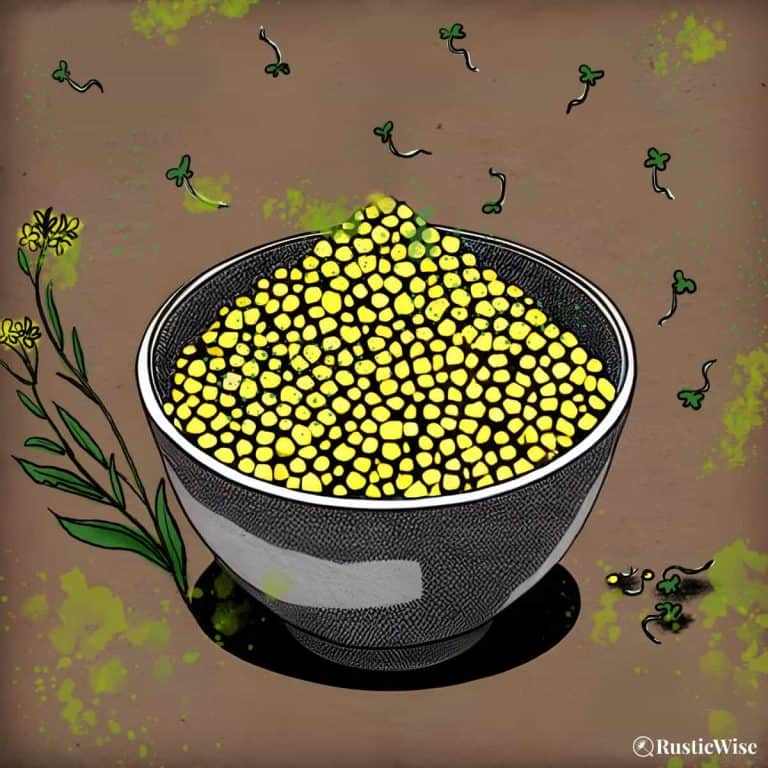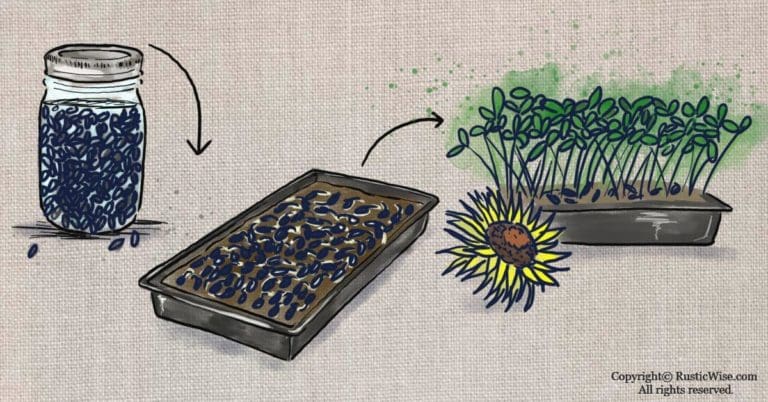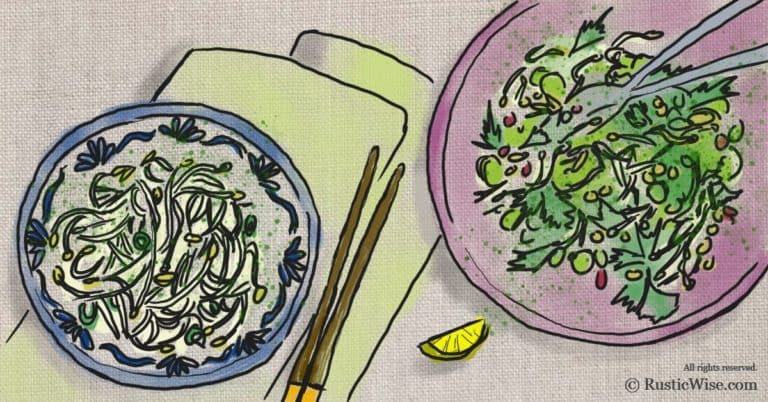5 Marvelous Cilantro Microgreen Benefits
You may have heard about the amazing health benefits of microgreens. Add cilantro to your list of one of the healthiest micros that scientific research has shown. With a bright, citrusy flavor and peppery notes, the cilantro herb is not only packed with nutrients, it’s also tasty.
So what are some cilantro microgreen benefits? The tiny greens of this herb contain more nutrients than the fully mature leaves of the plant. Cilantro micros contain exceptionally high levels of alpha-tocopherols (a form of vitamin E), carotenoids (which your body convers to vitamin A), and vitamin K.
Let’s take a closer look at the many benefits of this popular herb and how to use it to elevate your culinary game.
What exactly are cilantro microgreens?
Cilantro microgreens are simply the young shoots of the cilantro plant, grown from cilantro seed. They are harvested at a very young age when they’re no more than 2 to 3 inches tall (5 to 7 centimeters). This popular gourmet herb is a favorite of chefs as it pairs well with a variety of dishes from Asian, Italian, Mexican, and Middle Eastern cuisines. It’s used as a flavorful herb, or as a garnish.
Did you know that cilantro leaves come from the same plant (Coriandrum sativum) that produces the potent spice coriander? The leaves are a herb, while the dried seeds are used as a spice. Cilantro is also called Chinese parsley, or coriander (for those in the U.K.).
The microgreen version of cilantro is a more nutritious alternative to full-grown cilantro. It contains a higher concentration of nutrients than the mature leaves of the same plant. (More on this below!)
It’s ready to harvest in roughly 3 weeks. Compare this to the mature plant, which takes at least a month to harvest the leaves, and up to 3 months for the seeds to develop.
You can grow cilantro microgreens at home on a sunny windowsill, or under a grow light.
What do cilantro microgreens taste like?
The microgreen version of cilantro shares a similar flavor to its mature counterpart—fresh, citrusy, and herbaceous, with peppery notes. You’ll also enjoy a sweet and fragrant aroma.
BUT, there’s one key difference: cilantro micros don’t have the so-called “soapy” or dirt-like taste some people experience when eating the mature leaves.
I’ve never experienced this soapy flavor when eating the mature herb (thankfully!). But you won’t have to worry about this with the micro version.
Researchers have pinpointed this phenomenon to special compounds in the plant called aldehydes. A genome-mapping study of those of European descent found that this distaste for the herb is linked to a genetic component which causes an alteration in taste perception.¹
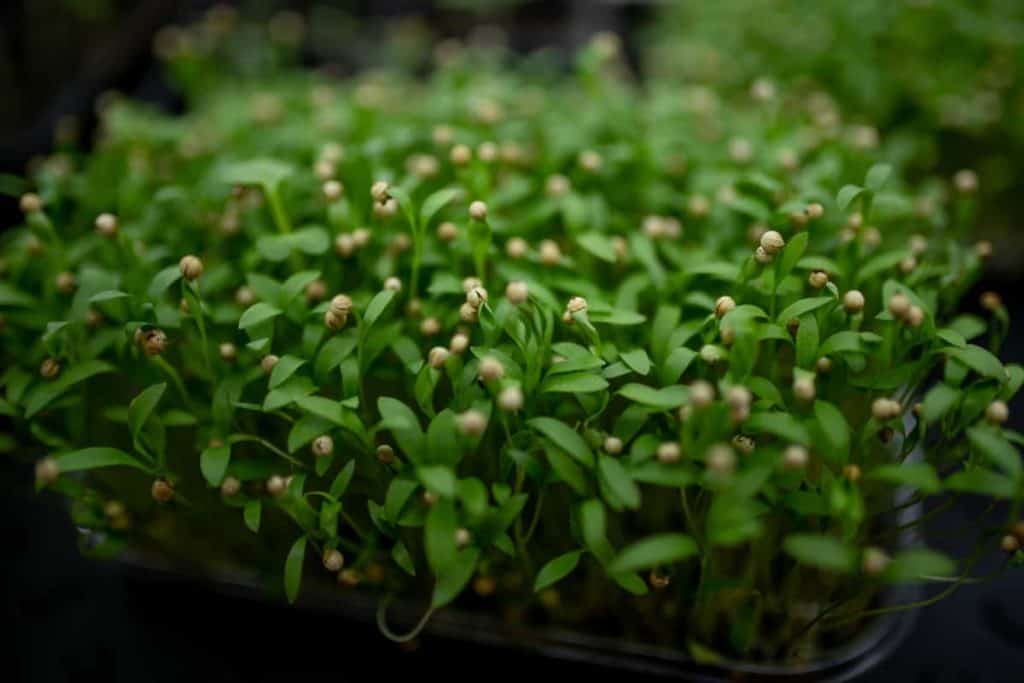
Credit: Deposit Photos
5 Marvelous cilantro microgreen benefits for better health
You may already know that regular cilantro is a good source of nutrients. For one, it’s a surprisingly good source of plant-based protein. It’s comprised of roughly 31 percent protein!²
Mature Coriandrum sativum also contains vitamins A, E, and K, along with phytonutrients. Just a ¼ cup serving of fresh leaves provides about 10 percent of the Daily Value of vitamin K.²
There was a groundbreaking study from 2012 conducted by researchers from the University of Maryland together with the USDA Agricultural Research Service (ARS) that examined 25 types of commercially grown microgreens and their nutritional properties.³
The top four micros that contained the highest levels of vitamin C, carotenoids (turns into vitamin A), vitamin K, and vitamin E are:
Let’s unpack some of the key results of studies on microgreens regarding cilantro.
1. Contains exceptionally high levels of carotenoids (a pre-cursor to vitamin A)
Beta-carotene (also known as provitamin A) is a type of carotenoid. This is a valuable fat-soluble antioxidant which protects the body’s cells from harmful free radicals.
The 2012 study discovered that cilantro microgreens have three times the amount of beta-carotenes than its mature counterpart.² Out of the 25 microgreens examined, Coriandrum sativum came second (red sorrel claims the top spot).
Lutein and zeaxanthin
These two carotenoids play a crucial role in prevention of vision problems related to aging such as cataracts and macular degeneration. Cilantro contains the HIGHEST levels of lutein and zeaxanthin of the 25 micros examined. A serving of cilantro microgreens can help promote eye health.
Violaxanthin
Violaxanthin is a type of orange-hued carotenoid with powerful anti-inflammatory and antioxidant effects. Cilantro microgreens contain more than 5 times the amount of violaxanthin than its mature leaves.
2. Cilantro microgreens are rich in alpha-tocopherols (a form of vitamin E)
Cilantro micros are a good source of vitamin E. In the 2012 study, cilantro came second (only to green daikon radish) for the highest levels of alpha-tocopherols.
Tocopherols are also known as vitamin E, an important fat-soluble antioxidant. Vitamin E is a strong antioxidant that protects against free radicals and may help prevent or delay the onset of Alzheimer’s disease.⁴
3. Chock-full of vitamin K (phylloquinone)
Vitamin K plays a key role in promoting healthy blood coagulation. It activates calcium and protein to aid in blood clotting.
Usually we can find this vitamin in leafy or dark-green vegetables such as spinach, kale, or broccoli.
Cilantro micros contain similar high levels of vitamin K as that of baby spinach. So, a sprinkle of this culinary herb can give you the nutritional boost you need!
4. A great source of other nutrients
Besides the above mentioned health benefits, cilantro microgreens are also a source of vitamin C and dietary fiber, along with minerals such as, calcium, copper, iron, magnesium, manganese, potassium, phosphorous, and zinc.
It’s a low-calorie, yet nutritionally dense food.
5. Cilantro may have anti-convulsive properties
Scientists at the University of California, Irvine have discovered that cilantro may indeed help delay seizures in those with epilepsy and other diseases. While many herbs such as cilantro have been used as folk medicine for centuries as an anti-convulsant, there is now scientific evidence to support this claim.⁵
This culinary herb helps to activate certain potassium channels in the brain to alleviate seizures. A special compound in cilantro “…called dodecenal, binds to a specific part of the potassium channels to open them, reducing cellular excitability.”⁵
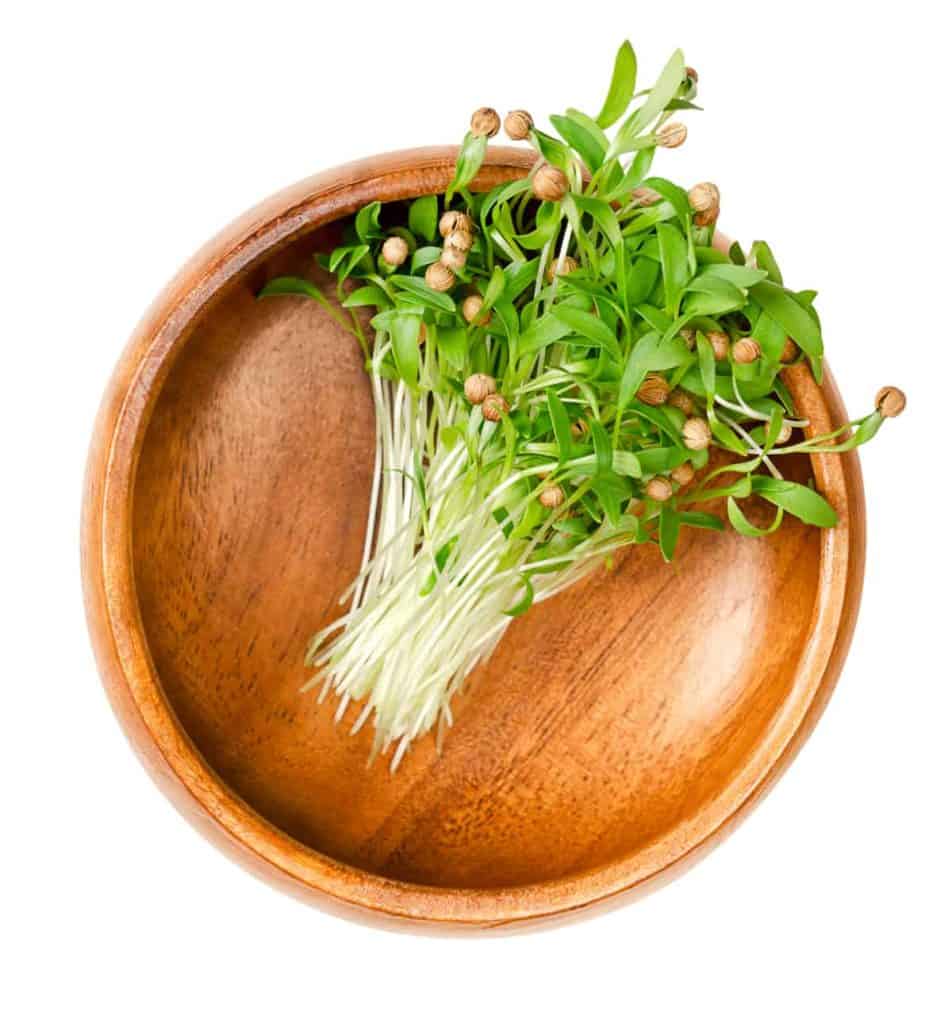
Tips on growing your own cilantro micros at home
You can easily germinate your own cilantro seeds and grow a tray of microgreens at home.
They are ready to harvest between 16 and 25 days, which is considered a slow-growing variety in the face-paced world of microgreens. But your patience will be well rewarded with a tasty and nutritious green packed with the cilantro flavor many people love.
There is no need to presoak these seeds. Simply scatter microgreen seed across a thoroughly moistened growing medium and cover until it germinates. Once you see little shoots, uncover and place in the sun. Water as needed, but avoid overwatering as this herb doesn’t like too much H₂0!
You can either harvest once the cotyledons have fully developed, or wait another week for the true leaves to appear. Either way, you’ll have a tasty herb to enjoy.
How to use cilantro microgreens in the kitchen
Cilantro is one of the oldest culinary herbs. It was found in the tomb of King Tutankhamen, and is believed to have been cultivated by the ancient Egyptians.⁵
Cilantro is most popular due to its distinctive flavor. The microgreens have an fresh, herby flavor similar to parsley (with peppery notes), which makes them a great addition to salads, salsas, and stir fry dishes.
Toss it on top of a simple salad. Use it as a garnish on roasted poultry, meat, or fish dishes. Add it to soups, stews and omelets. Cilantro microgreens are also a delicious addition to sandwiches, vegetarian dishes, tacos and more!
👉 If you like this post, see our Complete Guide to Growing Microgreens at Home. 🌱
Would you like more timeless tips via email?
Fun tips to help you live an independent, self-sustaining lifestyle. Opt-out at any time.


References
- Colorado State University School of Public Health, Cilantro, https://fsi.colostate.edu/cilantro/. Accessed January 2023.
- My Food Data, Cilantro, Coriander (Cilantro) Leaves Raw, https://tools.myfooddata.com/nutrition-facts/169997/. Accessed January 2023.
- Lester, Gene & Xiao, Zhenlei & Luo, Yaguang & Wang, Qin. (2013). Microgreens: Assessment of Nutrient Concentrations. Journal of Agricultural and Food Chemistry. https://dx.doi.org/10.1021/jf300459b
- Harvard Health, Listing of Vitamins, https://www.health.harvard.edu/staying-healthy/listing_of_vitamins. Accessed January 2023.
- University of California, Irvine, New study explains the molecular mechanism for the therapeutic effects of cilantro, https://www.som.uci.edu/news_releases/therapeutic-effects-of-cilantro.asp. Accessed January 2023.

Author: Theresa Tesolin
Theresa is co-founder of RusticWise. She helps people unleash their inner DIY spirit by encouraging them to get dirty and make or grow something from scratch.

